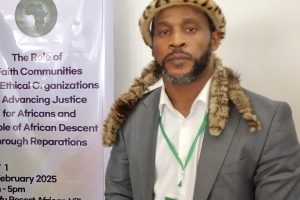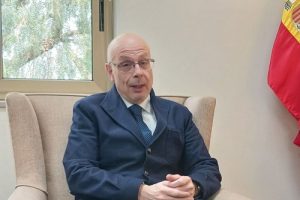
Today’s guest, Julie Mulonga, is currently a Director of Wetlands International Eastern Africa. After completing her primary and secondary education, she obtained a Bachelor’s Degree in Biology, followed by a postgraduate diploma in Integrated Water Resources Management, and a Master of Science in Environmental Planning and Management.
Currently, she is pursuing a PhD in Climate Change & Adaptation to gain a better understanding of the vulnerabilities of communities living adjacent to wetlands.
Over the past 24 years, she has worked in the water resources management sector for both the government and NGOs. Streams that once flowed freely through her neighborhood when she was a young girl no longer exist or are heavily polluted. Her concern over the depleting water resources inspired her to passionately work in the sector.
While working with Wetlands International for the past 11 years, as the Director of East Africa, she considers the opening of new offices in Tanzania, Uganda, and Ethiopia to be one of her proudest moments. During her time in Ethiopia for wetland-related tasks, The Ethiopian Herald had a brief stay to learn more about the causes and measures taken in the East Africa region to protect the ecosystem in general, and wetlands in particular. Enjoy the read!
Let us start our discussion by elaborating the meaning and significance of conserving wetland in general?
Wetlands are areas where land meets water, typically six meters or less according to the Ramsar Convention on Wetlands. These areas play a vital role in water storage, regulation, and purification, often referred to as the “kidneys of the earth.” Despite their importance, wetlands are often misunderstood and undervalued, leading to their degradation and destruction.
The impacts of climate change and the stress on freshwater resources is in large part due to the loss and degradation of wetlands. In turn, the changing climate means the world’s water is under unprecedented pressure, impacting human and food security.
But water – and wetlands – are not just victims of the climate and nature crises, they are central to solving them. With 35% loss globally in the last 50 years, mainly driven by land-use change, wetlands are our most threatened ecosystem, disappearing three times faster than forests.
Africa needs to restore and reconnect wetlands across all landscapes to increase resilience and reduce the impact of floods, wildfires and droughts. Reconnecting wetlands across natural landscapes and halting drainage is the basis for solving the challenges of water, food, climate, land degradation and sustainable economies.
In East Africa, wetlands play a crucial role in mitigating the impacts of recurrent droughts and floods. By storing and slowly releasing water, wetlands serve as lifelines for pastoralists and other communities, helping to reduce the severity of droughts and floods. However, the increasing frequency and intensity of climate change-related events pose a significant threat to wetlands and the communities that depend on them.
We are part of Wetlands International, a global NGO based in the Netherlands, making us an international organization. Our primary focus is on the conservation and restoration of wetlands, and we are the only organization that exclusively concentrates on wetlands. With years of experience in the field, we have been actively engaged in Ethiopia for the past five years, working on various programs ranging from policy issues, education, community involvement, wetland restoration, livelihood support, and facilitating consensus among stakeholders on critical wetland issues.
Wetlands International was established in 1959, initially as an organization dedicated to bird conservation. However, the realization that birds depend on critical wetland habitats led us to expand our focus to wetlands in collaboration with other organizations, leading to our current identity as Wetlands International.
Could you tell us more about the Ramsar convention?
The Convention on Wetlands is the intergovernmental treaty that provides the framework for the conservation and wise use of wetlands and their resources. The Convention was adopted in the Iranian city of Ramsar in 1971 and came into force in 1975.
Its mission covers the wise use of wetlands for their ecosystems and also their water resources. The Convention therefore works particularly closely with the six other biodiversity-related Conventions, and with those concerned with water governance.
The Convention has devoted a great deal of effort to developing synergies with these other environment-related instrument. There are several countries who are party to this convention, including most countries in Eastern Africa, though Ethiopia is yet to become party to the Ramzar Convention. Indeed, they are still working on it.
As you know, the East African countries are exposed for recurrent drought. So what is the very factor for this?
Now, picking up from where I left off, wetlands are important because they store that water. Then during the drought period, they release the water very slowly. So, we actually refer to them as blue lifelines, because they support, especially the pastoralists, this is where they get their water from.
Apart from that, when there are a lot of floods, these wetlands are actually able to absorb some of those floods. So they are actually able to help with attenuating or reducing the force of droughts. So you find in some watersheds where the wetlands have been removed, there is nothing to actually hold that water. So the water actually ends up going with a lot of force, and it destroys certain places. So we are not only talking about droughts, but we are also talking about floods that affect communities.
Right now we are hearing about a lot of communities being washed away by the floods. But I believe if there were wetlands there, they would be able to hold this water and prevent it from washing villages and communities in other areas. So in terms of droughts, they are very critical.
If we are able to conserve a lot of these wetlands, I believe a lot of communities would be able to get water from them during the dry period.
Would you please tell us about the best practice gained so far and the challenge you have faced in conserving the wetlands in the east African countries?
Through our work in East African countries, we have witnessed several best practices in wetland protection and management. Countries like Uganda have implemented robust wetland policies and management plans, emphasizing the importance of community engagement, livelihood support, and capacity building. These initiatives have led to tangible improvements in wetland conservation and restoration efforts, showcasing the positive impact of integrated approaches to wetland management.
Challenges in expanding our programs in East Africa include establishing partnerships, navigating diverse regulatory environments, and ensuring effective community engagement. Building trust, capacity, and awareness among stakeholders is essential for the successful implementation of wetland conservation initiatives.
Climate change poses a significant threat to wetlands, affecting water levels, biodiversity, and ecosystem functions. As temperatures rise and rainfall patterns shift, wetlands face increased pressure from floods, droughts, and habitat degradation. Addressing these challenges requires a holistic approach that integrates climate change adaptation strategies into wetland conservation and management efforts.
Flooding is one of the serious challenges that the east African countries are facing? What should be the role played by the East African countries in that regard?
In response to flooding and water management challenges, East African countries must adopt proactive measures, such as early warning systems, integrated water resource management approaches, and stakeholder engagement. By incorporating scientific knowledge, policy frameworks, and community participation, governments can better prepare for and mitigate the impacts of floods and water-related disasters.
The Ethiopian government’s tree planting initiatives have the potential to contribute to wetland conservation by enhancing soil stability, reducing erosion, and providing habitat for biodiversity. However, the success of these efforts depends on careful species selection, community involvement and long-term monitoring to ensure the survival and growth of planted trees.
In conclusion, raising awareness, fostering collaboration, and adopting sustainable practices are essential for safeguarding wetlands in East Africa. By recognizing the value of wetlands, integrating climate change considerations, and engaging diverse stakeholders, we can work together to protect these vital ecosystems for future generations.
How are countries in the horn managing their water resources? Construction of dams is contributed for the existence of artificial wetlands. Would you comment in that?
Someone is polluting the water. Who is responsible for this pollution? How will they be held accountable? We are starting to realize some important things that I appreciate. In the past, small-scale producers used water without considering the amount they were using. Now, there is a growing awareness that people need to recognize and be accountable for the water they use. Previously, they would extract water from rivers without considering the impact. This issue is now being taken more seriously, especially in African countries.
One positive development is the Integrated Water Resources Management (IWRM) approach, which brings stakeholders in the catchment area together. For example, in Ethiopia, the Rift Valley platform has been established to bring together various stakeholders, including the private sector and government. This initiative, led by the government, is a powerful step towards better water management.
Regarding artificial wetlands created by dams, there is controversy surrounding their construction. While dams provide benefits like hydroelectric power and water for agriculture, there are concerns about their impact on water bodies. It is essential to conduct thorough studies to understand and mitigate these effects. Development cannot be halted, but it can be informed by science to ensure a win-win situation for wetlands, governments, and communities.
Apart from raising awareness of the society, what are the major areas of intervention that your organization provides?
In terms of Wetlands International’s support for communities and governments, youth engagement is crucial. Youth and school children play a vital role in spreading awareness about wetlands to their families and communities. Additionally, the organization lobbies for funding to support projects, such as the one in Ethiopia supported by Swedish International Development Cooperation Agency (SIDA). By targeting different levels of stakeholders, including governments and donors, Wetlands International aims to make a positive impact.
My recent visit to Hawassa involved planning for the next six years until 2030 to align the organization’s strategies with national and international initiatives. The focus is on addressing wetland issues strategically and tapping in to available resources. By identifying key landscapes like Lake Hawassa, the organization aims to implement sustainable interventions for better management.
Overall, the goal is to conserve not just individual lakes but the entire catchment areas. By fundraising and implementing projects in various wetland areas, Wetlands International hopes to make a significant difference.
These are the questions I have for you today. If you would like to raise more relevant points, please take a chance?
What I would just like to reiterate is for a long time, we have not taken our wetlands seriously. Thus, we need to start taking these wetlands much more seriously. They are being cleared for agriculture and various other uses. I think it is got to get to a stage where we need to stop that and conserve these wetlands because of their importance. They trap the water so they can help us with floods and minimize droughts. Apart from storing carbon, wetlands are also helping us in terms of mitigating climate change.
Wetlands hold some of the largest stores of carbon on the planet, but when disturbed or drained they release the three major heat-trapping GHGs: carbon dioxide (CO2), methane (CH4) and nitrous oxide (N2O, mainly from ditches). At the same time, degraded wetlands fail to sustain essential ecosystem services such as food, freshwater supply, erosion, and flood control, all vital also in the context of climate change adaptation.
Since they can become a huge source of emissions upon degradation, by conserving and restoring wetlands, such as mangroves, you are addressing emissions at the source and enhancing removals, while also enhancing water resilience and other adaptation co-benefits.
Measures to transition to more sustainable paths should take into account effects and impacts on ecosystems, including wetlands (e.g. clean energy transition, sustainable agriculture), and local and indigenous communities.
Thus, I think we need to get to a stage where we are taking our wetlands seriously bringing all the sectors to the table. Because what I find is that different sectors treat wetlands differently. So, we all need to come to the table and start talking about this resource called water. I think once we do that, then we will be able to conserve it in a much better way.
Thank you very much for your willingness.
It is my pleasure!
BY GIRMACHEW GASHAW
THE ETHIOPIAN HERALD SATURDAY 20 APRIL 2024





